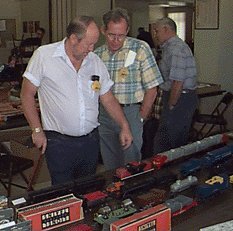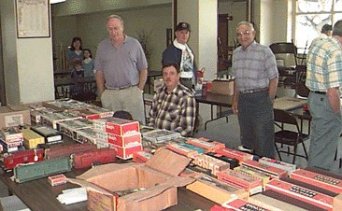|
|
The Train Collectors Association Western Division |
 |
[Home] [About our club] [Upcoming Meets & Location] [Membership & Officers] [Western Division History] [Meet Scenes Gallery] [TCA Kids Club] [Train Collecting Tips] [Grading Standards] [Useful Links] [Newsletters] [Manufacturers Index] [Meet Layout Videos] [Souvenir Club Car] [Home Layout Tour]
Train Collecting Tips
In the United States Lionel is the most collectible, followed by American Flyer and Marx. Lesser known American made brands such as Ives, Carlisle & Finch, Voltamp, Boucher, Dorfan, Hafner, Hoge, Buddy L, Howard, Thomas Industries, Kusan, AMT/Auburn, E.P. Alexander/American Model Railroad Co., and Knapp Electric all existed in the 20th century and are no longer in business, so the products that they produced are hard to find and have value to collectors.What You Should Know
We constantly receive e-mails from people wanting to know the value of an antique toy train that they have discovered in an attic, or have inherited from a family member. The Train Collectors Association does not perform appraisals or provide values for toy trains. Actual selling prices for antique toy trains will always depend on several different factors, including how motivated the buyer and the seller are, the location, and economic climate. The skills of the buyer at bargaining and the seller at promoting also effects the price. It is impossible to combine all these factors and arrive at one definitive price for any single antique toy train item. Keep this in mind when making purchases, or looking to sell items. Here are a few things to remember that can assist with obtaining valuable items for a collection, or in liquidating any item or a whole collection:
1. Scarcity helps determine value. The rarest of trains can be worth tens of thousands of dollars. Rarity is an important element of collecting. However, there are items that show up regularly, but are in such great demand with collectors, that the prices are higher than expected. Conversely, some items are hard to find, but have a low price tag because collectors are not interested in them. When the manufacturers issued their trains, some were not as popular and met with lower sales, and thus the manufacturers produced small quantities of these models. A train item that has low production numbers may be considered rare, but if the model was not popular, it may not be as desireable with collectors as more popular items that were produced in greater quantities.
There are several foreign manufacturers who made toy and scale model trains that have also become popular with collectors and could be worth something. These brand names include British companies like Bassett-Lowke, Hornby, Tri-ang, Exley, Wrenn and Leeds. The most famous producers in Germany included Bing, Bub, Georges Carette, Märklin, Fleischmann, Schöenner, Hess, LGB, Ernst Plank, Issmayer, Doll et Cie., Fandor, Arnold, and Trix/Trix Express. Major manufacturers in France included Jep, Jouef, Edobaud, Le Rapide, Charles Rossignol CR, and Vollon et Brun/VB. Other notable European brands include Italian manufacturers Elettren, Rivarossi and Lima, the Austrian producers Roco and Liliput, Spanish producer Paya, Swiss producers Hag and Fulgurex to name a few. The Soviet Union even produced collectible trains called Moskobel while Japan contributed their Seki/Sakai Trains, and Australia had Robilt.
 3. Original price plays a large part in determining
value. An old Lionel that originally sold for $50 might now be worth $100; but a Lionel of
the same year that sold for $100 may be worth $1000 now.
3. Original price plays a large part in determining
value. An old Lionel that originally sold for $50 might now be worth $100; but a Lionel of
the same year that sold for $100 may be worth $1000 now.
4. ‘O’ and ‘O-27’ gauge trains (the larger size trains) are normally most collectible, followed by Standard, 2" and S gauge. HO and N scale trains are normally not collectible; they’re worth not more than half of their original retail value no matter how old they are (exceptions are brass locomotives and some limited run plastics).
5. Condition means everything. An old Lionel train that looks great but won’t run is worth more than the same train in scruffy condition that runs like a Swiss watch.
 6. Having the original box the train came in will
add tremendously to the train’s value - even if the box has seen better days.
Original instruction sheets and packaging such as cardboard liners and spacers, or
shipping cartons also helps to increase the value of toy trains and accessories.
6. Having the original box the train came in will
add tremendously to the train’s value - even if the box has seen better days.
Original instruction sheets and packaging such as cardboard liners and spacers, or
shipping cartons also helps to increase the value of toy trains and accessories.
7. The more original parts the train has, the higher its value will be. Some old trains might be worth restoring; the majority are not. A restored train will tend to be worth less than the same item in an untouched condition.
8. Major variations in the standard body types, exterior colors and the size, color or placement of graphics on toy trains often will increase the worth of those items. Major variations are those which can be readily seen, exist in sufficient numbers so as to be attainable, and are accepted as legitimate collectible variations by the majority of experienced collectors. Minor variations are not worth more than the normal production version.
9. Mail order, retail, hobby and antique store prices for antique toy trains will generally tend to be higher since these establishments have overhead that must be built into the price of the goods sold. Prices for similar items found at train shows, train club meets, swap meets, garage sales, estate slaes, auctions and on the Internet will be somewhat less, since there is less operating overhead for those sellers.
Resources for Determining Value
There are several resources that can be utilized for determining the value and worth of tinplate toy trains. This includes published price guides, on-line auctions, TCA's "Interchange Point" published in the TCA National Headquarters News, and the TCA's on-line buy-trade-sell X-change web site.
There are a series of toy train books and price guides that were formerly published by Kalmbach Books. Even though that organization no longer exists, these guides are still available on web sites such as Trains.com. You can also look for train price guides published by TM Books or the Greenberg Guide Books series covering most all of the major collectible toy train gauges and manufacturers.
The Kalmbach books are called the "Greenberg Pocket Price Guides". The TM books are called "Price & Rarity Guides" and were written by long time train collectors and experts Tom McComas and James Tuohy. The values presented in these books are meant to serve only as a guide to collectors when buying and selling trains. These values are based on averaging the prices paid for train items bought and sold across the country at various train meets, private sales and auction houses. You can check with your local bookstore or public library for these price guides. Or search on-line bookstores for these pricing guides using the toy train manufacturer's name.
On-line auction sites such as eBay, Stout Auctions, Bertoia Auctions, Cabin Fever Auctions, Harris Toy Train Auctions and Lloyd Ralston Toys are excellent places to watch and track current prices being paid for various antique toy trains and toy train collectibles. These real-time Internet based auction transactions are the marketplace that establishes and demonstrates what the true worth of toy train collectibles are today.
You can contact any of these auction houses for an appraisal of a collection (there may be a fee charged) or you can try to find a personal property appraiser through various organizations such as:
Appraisers Association of America: https://www.appraisersassociation.org
American Society of Appraisers: http://www.appraisers.org
International Society of Appraisers: https://www.isa-appraisers.org
Certified Appraisers Guild: http://www.certifiedappraisersguild.org
Appraisal Foundation: https://www.appraisalfoundation.orgThe Train Collectors Association (TCA) also provides its members with excellent tools to help them determine the range of value of their antique toy trains. This activity is provided in several ways. One method is via the National Headquarters News, published 5 times annually on-line as part of the regular TCA membership offerings. The Headquarters News contains the Interchange Point, which is a detailed listing of train items wanted or up for sale or trade by members of the Train Collectors Association. Members are permitted to submit up to 12 items for listing in each issue for free, as a service of the club. TCA also publishes buy and sell listings in an on-line searchable web site system called the X-change, which allows for inclusion of a greater amount of item details and even photographs. Like the other on-line electronic Internet based venues previously mentioned, the Headquarter's News published listings and the on-line TCA X-change's listings, can be monitored and referenced for determining the value of similar train items. You must be a member of TCA in order to access these services.
The best and most effective method for figuring out the value that your toy or model trains have attained is to attend train meets and shows where these items are bought and sold to see the actual prices being paid. TCA Western Division conducts several of these shows or 'train meets' each year in various locations in the Southern California area. For a full listing of the current year schedule of these train meets, visit our web page here.
![]()
|
|

